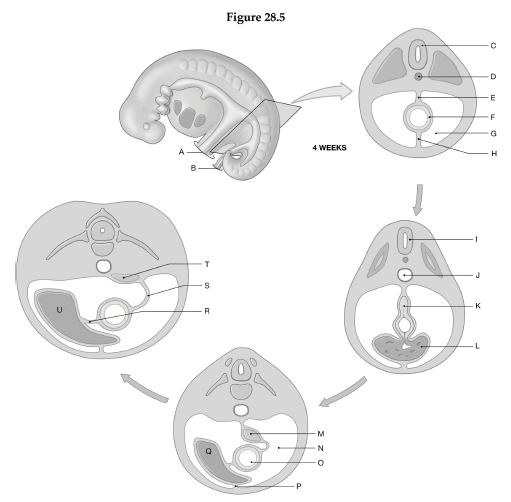Using the figure below, identify the labeled part.

1) Label A: ______________________________
2) Label B: ______________________________
3) Label C: ______________________________
4) Label D: ______________________________
5) Label E: ______________________________
6) Label F: ______________________________
7) Label G: ______________________________
8) Label H: ______________________________
9) Label I: ______________________________
10) Label J: ______________________________
11) Label K: ______________________________
12) Label L: ______________________________
13) Label M: ______________________________
14) Label N: ______________________________
15) Label O: ______________________________
16) Label P: ______________________________
17) Label Q: ______________________________
18) Label R: ______________________________
19) Label S: ______________________________
20) Label T: ______________________________
21) Label U: ______________________________
1) Yolk stalk
2) Body stalk
3) Neural tube
4) Notochord
5) Dorsal mesentery
6) Digestive tube
7) Coelomic cavity
8) Ventral mesentery
9) Neural tube
10) Aorta
11) Pancreas
12) Liver
13) Pancreas
14) Coelom
15) Stomach
16) Falciform ligament
17) Liver
18) Lesser omentum
19) Greater omentum
20) Pancreas
21) Liver
You might also like to view...
Tonsils located lateral walls of pharynx are called the
A) esophageal tonsils. B) palatine tonsils. C) lingual tonsils. D) pharyngeal tonsils. E) epiglottal tonsils.
Which of the following is NOT true about nets used to capture fish?
a. Nets should be soft and move easily. b. The net should be moved fast to catch fish. c. Nets should be dark in color. d. If fins become caught in the net, they can be cut free with scissors.
Peristalsis, which is controlled by ____, describes the movement of food along the digestive tract
a. skeletal muscle b. nervous tissue c. cardiac muscle d. smooth muscle
On what bone are the superior nasal conchae found?
A) Zygomatic B) Ethmoid C) Sphenoid D) Lacrimal